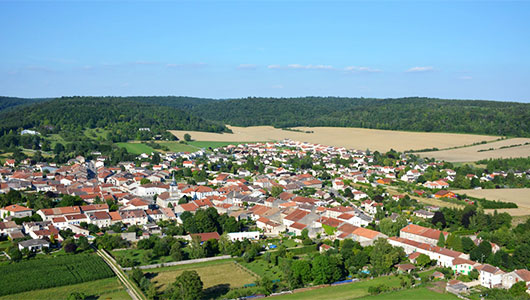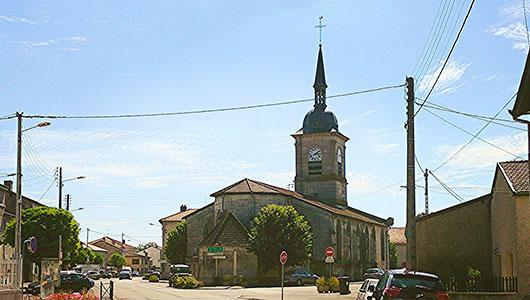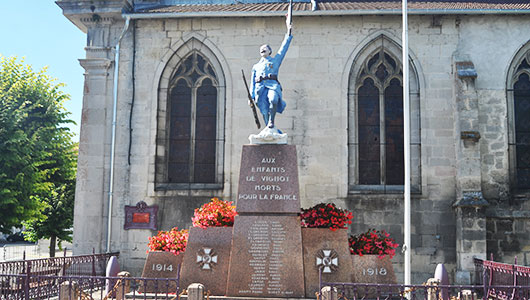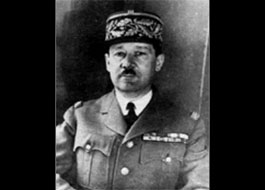Vignot
Durée visite : 45 min
Moyen : Pédestre
Attesté en 1136 seulement, Vignot est habité à l’époque mérovingienne, car des tombeaux de cette époque ont été retrouvés. L’histoire du village est en grande partie liée à celle de Commercy. Deux autres localités, disparues au XIIe siècle, se trouvaient à proximité : Morville et Massereville. Possession des seigneurs de Commercy, la bourgade est affranchie en 1336 par Jean de Sarrebruck. En 1588, Vignot passe entre les mains des ducs de Lorraine. Quelques années plus tard, en 1609, Charles III confirme l’affranchissement du village. Vignot est érigé en prévôté pour Jean d’Urres, puis dévasté par les guerres en 1643. Au XIXe siècle, de nombreuses activités économiques font vivre le village : moulins à eau, carrières, scierie, usine électrique. Parmi les enfants du pays se trouvent l’architecte Jean Thiriot (vers 1590-1649) et le général de division Jean Verneau (1890-1944) mort en déportation à Buchenwald.
Attested only in 1136, Vignot was inhabited during the Merovingian period, because tombs from this period have been found. The history of the village is largely linked to that of Commercy. Two other localities, which disappeared in the 12th century, were nearby: Morville and Massereville. Possession of the lords of Commercy, the town was freed in 1336 by Jean de Saarbrücken. In 1588, Vignot passed into the hands of the Dukes of Lorraine. A few years later, in 1609, Charles III confirmed the enfranchisement of the village. Vignot was set up as a provost for Jean d’Urres, then devastated by wars in 1643. In the 19th century, numerous economic activities brought the village to life: water mills, quarries, sawmill, electrical factory. Among the children of the country are the architect Jean Thiriot (circa 1590-1649) and the major general Jean Verneau (1890-1944) who died in deportation to Buchenwald.
Vignot wurde erst 1136 bezeugt und war während der Merowingerzeit bewohnt, da Gräber aus dieser Zeit gefunden wurden. Die Geschichte des Dorfes ist weitgehend mit der des Handels verbunden. Zwei weitere Orte, die im 12. Jahrhundert verschwanden, befanden sich in der Nähe: Morville und Massereville. Im Besitz der Handelsherren wurde die Stadt 1336 von Jean de Saarbrücken befreit. 1588 ging Vignot in die Hände der Herzöge Lothringens über. Einige Jahre später, 1609, bestätigte Karl III. Die Entrechtung des Dorfes. Vignot wurde als Provost für Jean d’Urres errichtet und 1643 von Kriegen zerstört. Im 19. Jahrhundert erweckten zahlreiche wirtschaftliche Aktivitäten das Dorf zum Leben: Wassermühlen, Steinbrüche, Sägewerk, Elektrofabrik. Zu den Kindern des Landes zählen der Architekt Jean Thiriot (um 1590-1649) und der Generalmajor Jean Verneau (1890-1944), die bei der Deportation nach Buchenwald starben.

D’argent au pampre de vigne de sinople, fruité de quatre grappes de pourpre.
Vignot est un ancien village de vignerons
Argent with a vine branch Vert, fruity with four bunches of purple.
Vignot is an old village of winegrowers.
Argent mit einem Weinzweig Vert, fruchtig mit vier lila Trauben.
Vignot ist ein altes Dorf der Winzer.

Les habitants et les habitantes de la commune de Vignot s’appellent les Vignotins et les Vignotines.
The inhabitants of the commune of Vignot are called Vignotins and Vignotines.
Die Bewohner der Gemeinde Vignot heißen Vignotins und Vignotines.
Les points de visites
.
Ce lavoir est très lumineux grâce à sa série de verrières. Devant lui se trouve une fontaine avec un chérubin aux membres tronqués. Lieux essentiels de la vie villageoise, les lavoirs sont souvent construits au XIXe siècle par les municipalités. Elles sont soucieuses du bien-être de leurs habitants et du développement de l’hygiène.
This wash house is very bright thanks to its series of glass roofs. In front of him is a fountain with a cherub with truncated limbs. Essential places of village life, washhouses were often built in the 19th century by municipalities. They are concerned about the well-being of their inhabitants and the development of hygiene.
Dieses Waschhaus ist dank seiner Reihe von Glasdächern sehr hell. Vor ihm steht ein Brunnen mit einem Cherub mit abgeschnittenen Gliedmaßen. Waschhäuser wurden im 19. Jahrhundert häufig von Gemeinden gebaut. Sie sind besorgt um das Wohlergehen ihrer Bewohner und die Entwicklung der Hygiene.
.
.
Cette église sert de maison forte et de refuge aux habitants du village. En 1634, une chambre secrète est aménagée. Elle sert à cacher les titres de la commune et les ornements de l’église. Plusieurs indices, une archère en particulier, située au-dessus du collatéral gauche, laissent penser que l’église était fortifiée. Au XIXe siècle, une tour romane est détruite afin d’aménager la tour et la façade ouest de l’église, sur un modèle qui rappelle celui de l’église de Lérouville.
This church serves as a stronghold and refuge for the inhabitants of the village. In 1634, a secret room was fitted out. It is used to hide the titles of the town and the ornaments of the church. Several clues, an archer in particular, located above the left aisle, suggest that the church was fortified. In the 19th century, a Romanesque tower was destroyed in order to fit out the tower and the west facade of the church, on a model reminiscent of that of the Lérouville church.
Diese Kirche dient als Festung und Zuflucht für die Bewohner des Dorfes. 1634 wurde ein Geheimraum eingerichtet. Es wird verwendet, um die Titel der Gemeinde und die Ornamente der Kirche zu verbergen. Mehrere Hinweise, insbesondere ein Bogenschütze, der sich über dem linken Gang befindet, deuten darauf hin, dass die Kirche befestigt war. Im 19. Jahrhundert wurde ein romanischer Turm zerstört, um den Turm und die Westfassade der Kirche nach einem Modell auszurüsten, das an das der Lérouville-Kirche erinnert.
.
Né à Vignot en 1890
mort à Buchenwald le 14 septembre 1944.
Polytechnicien , il est colonel en 1940, promu général de division à titre posthume.
Ancien chef d’état-major du général Noguès à Alger, il y est nommé chef de la délégation des services de l’armistice en août 1940. En février 1941, il devient chef d’état-major de l’armée d’armistice. Il donne son accord tacite aux actions clandestines de camouflage de matériel : stockage et entretien d’armes et de munitions qui serviront plus tard aux maquis, organisation de réseaux clandestins de transmissions.
Chef d’état-major de l’armée d’armistice en juin 1942, il participe à la fondation de l’Organisation de résistance de l’armée (ORA) dès la dissolution de l’armée d’armistice en novembre 1942. Il rejoint le commandant Cogny qui a créé une branche de l’organisation en zone Nord. Il succède en juin 1943 au général Aubert Frère à la tête de celle-ci. Arrêté le 23 octobre 1943, il désigne son successeur, le général Georges Revers, puis est déporté à Buchenwald, où il meurt le 14 septembre 1944, à 54 ans.
died in Buchenwald on September 14, 1944.
Polytechnician, he was colonel in 1940, promoted to division general posthumously.
Former Chief of Staff of General Noguès in Algiers, he was appointed head of the armistice services delegation there in August 1940. In February 1941, he became Chief of Staff of the Armistice Army . It gives its tacit agreement to clandestine actions of material camouflage: storage and maintenance of weapons and ammunition which will later be used by the maquis, organization of clandestine communication networks.
Chief of Staff of the Armistice Army in June 1942, he participated in the founding of the Army Resistance Organization (ORA) upon the dissolution of the Armistice Army in November 1942. He joined Commander Cogny who created a branch of the organization in the North zone. In June 1943, he succeeded General Aubert Frère at the head of the latter. Arrested on October 23, 1943, he appointed his successor, General Georges Revers, then was deported to Buchenwald, where he died on September 14, 1944, at the age of 54.
starb am 14. September 1944 in Buchenwald.
Der Polytechniker, er war 1940 Oberst, wurde posthum zur Generalabteilung befördert.
Der ehemalige Stabschef von General Noguès in Algier wurde im August 1940 zum Leiter der dortigen Delegation für Waffenstillstandsdienste ernannt. Im Februar 1941 wurde er Stabschef der Waffenstillstandsarmee . Es gibt seine stillschweigende Zustimmung zu geheimen Aktionen der materiellen Tarnung: Lagerung und Wartung von Waffen und Munition, die später von der Macchia verwendet werden, Organisation von geheimen Kommunikationsnetzen.
Als Stabschef der Waffenstillstandsarmee beteiligte er sich im Juni 1942 an der Gründung der Army Resistance Organization (ORA) nach der Auflösung der Waffenstillstandsarmee im November 1942. Er schloss sich Commander Cogny an, der einen Zweig der Organisation in der Nordzone gründete. Im Juni 1943 trat er die Nachfolge von General Aubert Frère an dessen Spitze an. Am 23. Oktober 1943 verhaftet, ernannte er seinen Nachfolger, General Georges Revers, und wurde dann nach Buchenwald deportiert, wo er am 14. September 1944 im Alter von 54 Jahren starb.












